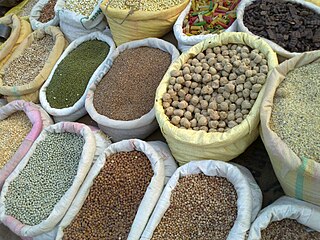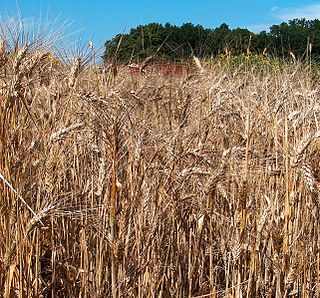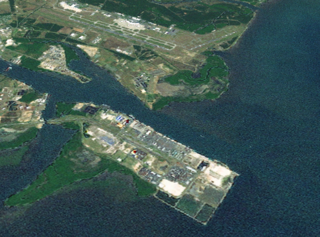
Port of Brisbane is the shipping port and coastal suburb of Brisbane, on the east coast of Queensland, Australia. It is located in the lower reaches of the Brisbane River on Fisherman Island, an artificial island reclaimed from the smaller Fisherman Islands group at the mouth of the river. It currently is the third busiest port in Australia and the nation's fastest growing container port. It includes the main shipping channel across Moreton Bay which extends 90 kilometres (56 mi) north to Mooloolaba and is dredged to maintain a depth of fourteen metres at the lowest tide.
The Port of Montreal is a port and transshipment point on the St. Lawrence River in Montreal, Quebec, Canada. On the Saint Lawrence Seaway 1,600 kilometres inland from the Atlantic Ocean, it is on the shortest direct route from Europe and the Mediterranean to North America. It is an international container port that services Toronto and the rest of Central Canada, the U.S. Midwest, and the U.S. Northeast.

Port of Townsville is a government-owned Corporation and seaport in Townsville, Queensland, Australia. It is the third largest seaport in Queensland after Port of Brisbane and the Central Queensland Port in Gladstone. It is located south of the mouth of Ross Creek and north of the Ross River. A second seaport, which only exports sugar is found about 100 kilometres (62 mi) north of Townsville at Lucinda and is also managed by Port of Townsville Limited.
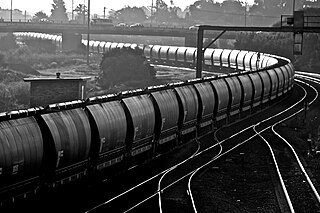
The Hunter Valley Coal Chain (HVCC) is the chain of coal delivery in New South Wales, Australia from coal mines in the Hunter Region to the Port of Newcastle and domestic coal-fired power stations in the Hunter Valley. The HVCC essentially follows the path of the Hunter River travelling south-east from the mining areas in the Hunter Valley to Newcastle.

Carrington is a suburb of Newcastle, New South Wales, Australia, and is named after Lord Carrington, governor of New South Wales in 1887 when the area was proclaimed a municipality.

The Port of Tauranga is situated in Tauranga, New Zealand. It is the largest port in the country both in terms of total cargo volume, and in terms of container throughput with container volumes exceeding 950,000 TEU's. The port is operated by Port of Tauranga Ltd. This article is about both the company and the port itself.
The Port of Constanța is located in Constanța, Romania, on the western coast of the Black Sea, 179 nautical miles (332 km) from the Bosphorus Strait and 85 nmi (157 km) from the Sulina Branch, through which the Danube river flows into the sea. It covers 3,926 ha, of which 1,313 ha is land and the rest, 2,613 ha is water. The two breakwaters located northwards and southwards shelter the port, creating the safest conditions for port activities. The present length of the north breakwater is 8.344 m (27.38 ft) and the south breakwater is 5.560 m (18.24 ft). The Port of Constanța is the largest on the Black Sea and the 4th largest in Europe.
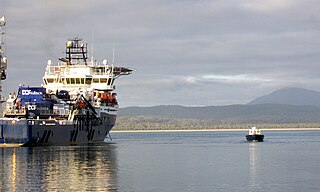
The Port of Eden is a small seaport situated in Twofold Bay, adjacent to the town of Eden, located in the South Coast region of New South Wales, Australia.

Port Botany is a deepwater seaport located in Botany Bay in Sydney, Australia. The port is dominated by trade in containerised manufactured products, and to a lesser extent, bulk liquid imports including petroleum and natural gas. It is one of Australia's largest container ports and is administered by NSW Ports which entered into a 99-year lease agreement with the NSW Government in May 2013.
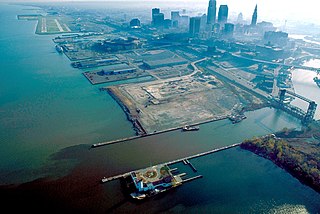
The Port of Cleveland is a bulk freight shipping port at the mouth of the Cuyahoga River on Lake Erie in Cleveland, Ohio, United States. It is the third-largest port in the Great Lakes and the fourth-largest Great Lakes port by annual tonnage.

Glebe Island was a major port facility in Sydney Harbour and, in association with the adjacent White Bay facility, was the primary receiving venue for imported cars and dry bulk goods in the region until 2008. It is surrounded by White, Johnstons, and Rozelle Bays. Whilst retaining its original title as an "island", it has long been infilled to the shoreline of the suburb of Rozelle and connected by the Glebe Island Bridge to Pyrmont.

The Port of Cork is the main port serving the South of Ireland, County Cork and Cork City. It is the second busiest port in Ireland and offers all six shipping modes i.e. Lift-on Lift-off, Roll-on Roll-off, Liquid Bulk, Dry Bulk, Break Bulk and Cruise. In 2012 9.05m tonnes of freight was shipped through the Port of Cork.

Qube Holdings Ltd is a diversified logistics and infrastructure company in Australia. It was founded in 2010 after the investment trust KFM Diversified Infrastructure and Logistics Fund acquired Kaplan Equity and became a standard operating company, rebranded as Qube Logistics. Kaplan Equity part owned P&O Automotive and General Stevedoring and P&O Trans Australia. Qube acquired outright control and majority ownership of P&O Trans Australia in April 2011.

Port Kembla is a man-made cargo port or artificial harbour, with an outer harbour protected by breakwaters and an inner harbour constructed by dredging, located in the Illawarra region of New South Wales, Australia.
The Hamilton Port Authority, created in 2001, replaced the Hamilton Harbour Commission. It derives its mandate from the Canada Marine Act, an act of Canada's federal Parliament. Hamilton is one of 19 Canadian ports that had port authorities created, because they were deemed essential to Canada's economic welfare.
Flinders Ports manages seven of South Australia's ten privately owned ports and is the state's largest port operator.

The Port Authority of New South Wales, is a corporation owned by the State Government of New South Wales, Australia. The Port Authority acts as harbourmaster at the State's six commercial seaports, managing shipping movements, safety, security and emergency response. While major cargo handling facilities are operated by the private sector, the Port Authority continues to manage smaller facilities including Sydney's two cruise terminals, at Circular Quay and White Bay; common user berths at Sydney's Glebe Island and White Bay; and the regional ports at Eden and Yamba.

Mackay Harbour is a coastal locality in the Mackay Region, Queensland, Australia. In the 2016 census, Mackay Harbour had a population of 555 people.
Apapa Port Complex also known as the Lagos Port Complex is Nigeria's largest and busiest port complex. The complex consist of a number of facilities including Apapa quays, Third Apapa Wharf Extension, Apapa Dockyard, Apapa Petroleum Wharf, Bulk Vegetable Oil Wharf, Ijora Wharf, Kirikiri Lighter Terminal, and Lily pond inland container terminal. Financed and built by the colonial government of Nigeria, It became the nation's busiest port for exporting agricultural produce from the provinces of Western and Northern Nigeria in the late 1920s. Administration was transferred to the Nigerian government upon the granting of self-government and In 2005, the complex was divided into terminals and contracted out to private operators with NPA acting as the landlord and regulator.








